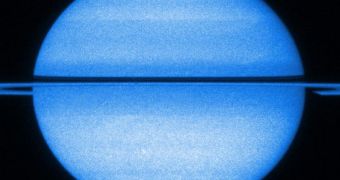Investigations carried out with the NASA Cassini orbiter around Saturn have revealed that the gas giant is sending out mixed radio signals. The planet's rotation causes variations in the radio waves it releases, but these variations are different between the northern and southern hemispheres.
In addition, it was also found that the rotational variations change with seasons, and that the hemispheres can literally swap these variation rates among themselves from time to time.
These findings underline just how little we know about the radio signals emanating from such planets. Until now, scientists were convinced they had figured these patterns out. It would now appear that there is a lot more to learn than previously thought.
The erroneous belief was fueled by the fact that Jupiter proved a little easier to understand in this regard. It's highly unlikely that Saturn's neighbor will reserve experts any more surprises.
“These data just go to show how weird Saturn is. We thought we understood these radio wave patterns at gas giants, since Jupiter was so straightforward,” explains scientist Don Gurnett.
“Without Cassini's long stay, scientists wouldn't have understood that the radio emissions from Saturn are so different,” he adds. The spacecraft achieved orbital insertion around Saturn on July 1, 2004.
Gurnett holds an appointment as a professor of physics at the University of Iowa in Iowa City. He is also the leader of the Cassini radio and plasma wave science team. The expert says that radio waves emanating from the gas giant are called the Saturn Kilometric Radiation (SKR).
A landmark paper published in a 2009 issue of the journal Geophysical Research Letters demonstrated that the radio waves produced by Saturn's northern hemisphere had a period of about 10.6 hours, whereas those produced near the south pole had a period of around 10.8 hours.
Another paper, published in the same journal in December 2010, showed that the two hemisphere swapped periods in March 2010, about seven months after equinox, scientists at the NASA Jet Propulsion Laboratory (JPL), in Pasadena, California, explain.
Experts operating Cassini now believe that these phenomena are produced by large-scale variations in high-altitude winds sweeping through both hemispheres. But the Sun may play a role in this as well.
“The rain of electrons into the atmosphere that produces the auroras also produces the radio emissions and affects the magnetic field, so scientists think that all these variations we see are related to the sun's changing influence on the planet,” explains Stanley Cowley.
The expert is a co-investigator on the Cassini magnetometer instrument, and he holds an appointment as a professor at the University of Leicester, in the United Kingdom.
“These papers are important in helping to explain the complicated dance between the sun and Saturn's magnetic bubble, something normally invisible to the human eye and imperceptible to the human ear,” adds JPL researcher Marcia Burton.
She is a Cassini fields and particles scientist, and was not involved in the investigations. “Cassini will continue to keep an eye on these changes,” the expert concludes.

 14 DAY TRIAL //
14 DAY TRIAL //